Autonomous underwater robot reduces ship fuel consumption (w/ Video)

As the U.S. Navy minimizes its dependence on foreign oil, the Office of Naval Research (ONR) is a front runner in supporting and bringing forth innovative solutions to fuel consumption challenges.
"One of the avoidable costs in fuel for the Navy is related to marine fouling such as barnacles that accumulate on ships," says ONR Program Officer Steve McElvany. "They create increased drag as these ships move from port to port across the world's oceans."
Known as a "hard fouler" for ships worldwide, colonized barnacles and biofilms on the hull of a Navy ship translate into roughly 500 million dollars annually in extra maintenance and fuel costs that are required to keep ships free of barnacles, oysters, algae and other marine life.
In fact, the Naval Surface Warfare Center at Carderock (NSWCCD) estimates that biofouling reduces vessel speed by up to 10 percent. Vessels can require as much as a 40 percent increase in fuel consumption to counter the added drag.
The Naval Materials Division of ONR's Sea Warfare and Weapons Department is sponsoring the research on environmentally safe antifouling solutions which is developing this innovation -- an autonomous underwater hull grooming robot.
"The best way to stop barnacles from colonizing is don't let them settle and colonize on the hull in the first place," advises McElvany. With that in mind, ONR recently conducted tests with a developmental ship hull grooming robot, called the Robotic Hull Bio-inspired Underwater Grooming tool or Hull BUG. The tests showed that this little groomer — similar in concept to a autonomous robotic home vacuum cleaner or lawn mower — has a lot of promise.
And, although the autonomous hull groomer looks simple enough as it goes about its business, a significant amount of innovation goes into its operation. In particular, the robot incorporates the use of a biofilm detector that utilizes modified fluorometer technology to enable the robot to detect the difference between the clean and unclean surfaces on the hull of a ship. Used to groom ships in port, the Hull BUG removes the marine biofilm and other marine organisms before they get solidly attached. This is especially important because Navy ships spend more than 50 percent of their service life in port, giving barnacles and marine life ample time to become settled and, if allowed, to further colonize and grow on the ship's hull.
Underscoring the benefits of combining the Hull BUG with newly developed environmentally benign antifouling hull coatings, McElvany estimates that "the Navy will save millions of dollars per year in fuel. Using less fuel also means less carbon dioxide in the atmosphere. We are really trying to look very far forward to get the ultimate solution."
ONR developed the Hull BUG and the antifouling hull coatings through its investments in new and innovative science and technology (S&T) aimed at building the Navy and Marine Corps' future force, maintaining warfighting readiness and ensuring warfighting dominance for today's Sailors and Marines. While originally focused on reducing the use of toxic antifouling hull paints, these investments have also yielded technology breakthroughs that reduce the use of fossil fuels and emission of greenhouse gas in the form of carbon dioxide and facilitate the Navy's commitment to environmental stewardship.
Partners in ONR's development of the Hull BUG include NSWCCD, SeaRobotics and the Florida Institute of Technology. ONR's partnerships provide the key to success for this innovative research and countless enhancements to our warfighter's capabilities. Since 1946, ONR has funded revolutionary research through academia, universities, government laboratories, nonprofit and for-profit organizations, and nearly 60 Nobel Laureates.
According to Bill Hertel, a mechanical engineer at NSWCCD, "Hull BUG is a complex project in the sense that it has to encompass many different areas of expertise. The ONR team is out to develop capabilities that do not currently exist to achieve realistic benefits that haven't yet been realized."
Geoff Swain, professor of Oceanography and Ocean Engineering at the Florida Institute of Technology, oversees ONR's Hull BUG testing and was impressed with the test results. "The Hull BUG autonomously groomed and removed biofilm from an area on the port midship section of the hull in a preprogrammed pattern," notes Swain. "Very exciting results."
Like other ONR projects, Hull BUG benefits will extend beyond the Navy. "Basically any boat over 45 feet, which is in the water all the time, can benefit from this kind of technology," says Don Darling, President of SeaRobotics.
Ken Holappa, a SeaRobotics engineer agrees. "Just like the Navy, the savings to the commercial shipping industry stand to be significant in terms of fuel efficiency and in reducing emissions associated with ship operations in our world's oceans."
"In the long term, it will be not one approach or one solution that solves the marine biofouling issue," says McElvany, "It is going to be a combination of things."
The Hull BUG is one of many examples of how ONR takes revolutionary research and delivers relevant results.
Source: Office of Naval Research

















